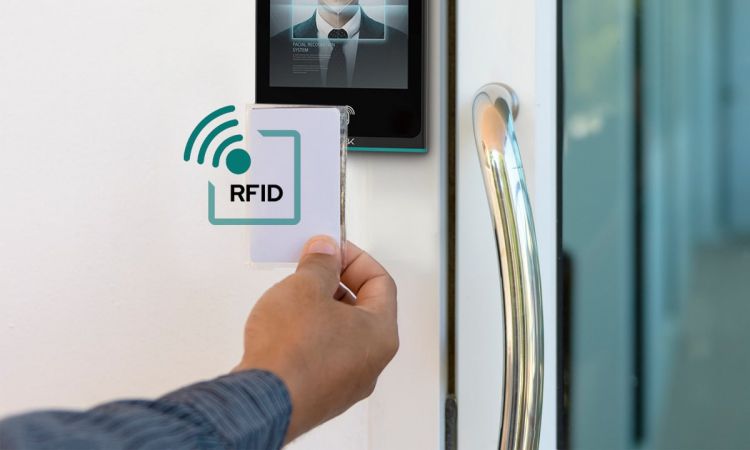 RFID, or radio-frequency identification, is a technology that allows for the wireless transfer of data between a reader and an electronic tag attached to an object or person. This technology has become increasingly popular for access control and authentication, as it provides a convenient and secure way to identify and verify the identity of individuals.
RFID, or radio-frequency identification, is a technology that allows for the wireless transfer of data between a reader and an electronic tag attached to an object or person. This technology has become increasingly popular for access control and authentication, as it provides a convenient and secure way to identify and verify the identity of individuals.
How RFID Access Control Works
RFID access control systems work by utilizing a reader to send out radio waves to communicate with RFID tags. The tags contain unique identifiers, which can be read by the reader when they come within range. This communication is often referred to as a “handshake,” as the reader and tag exchange data to verify the identity of the tag.
In an access control system, RFID tags are often attached to keycards or fobs, which can be distributed to individuals who need access to a restricted area. When a person approaches a door, they must present their keycard or fob to the reader, which will then check the tag’s identifier against a database to determine whether or not that person is authorized to enter the area. If the tag is valid, the door will unlock and the person will be granted access.
Advantages of RFID Access Control
RFID access control offers several advantages over traditional access control methods, such as using keys or passwords. One of the biggest advantages is convenience. With RFID, individuals can simply present their keycard or fob to the reader, without the need to fumble with keys or remember complex passwords. This makes the process of entering a restricted area much faster and more efficient.
RFID access control also offers greater flexibility than traditional access control methods. With a traditional key or password system, it can be difficult to manage access for large groups of individuals, especially if those groups need different levels of access. RFID tags can be programmed to allow different levels of access for different individuals or groups, making it much easier to manage access for a large organization.
RFID Authentication
RFID authentication is another application of RFID technology that is becoming increasingly popular. In this case, RFID tags are used to verify the identity of individuals, rather than granting access to a restricted area.
One common use of RFID authentication is for employee time tracking. Employees can be issued RFID tags, which they must present to a reader when they arrive at work and when they leave. This allows employers to track employee hours accurately, without the need for manual timecards.
RFID authentication can also be used for other purposes, such as verifying the identity of visitors or customers. For example, some hospitals have implemented RFID-based systems to identify patients and ensure that they receive the correct medication and treatment.
Advantages of RFID Authentication
RFID authentication offers many of the same advantages as RFID access control, including convenience and security. However, RFID authentication also offers some additional benefits.
One of the biggest advantages of RFID authentication is accuracy. Because RFID tags contain unique identifiers, it is much more difficult for individuals to impersonate someone else. This is particularly important in industries such as healthcare, where patient safety is paramount.
RFID authentication also offers greater flexibility than traditional authentication methods. For example, in a hospital setting, RFID tags can be used to identify patients and track their movements throughout the facility. This can help hospital staff quickly locate patients, monitor their condition, and ensure that they receive the appropriate care.
Challenges of RFID for Access Control and Authentication
While RFID technology offers many advantages for access control and authentication, there are also some challenges to consider.
One challenge is the potential for interference. Because RFID tags rely on radio waves to communicate with readers, interference from other devices or materials can sometimes cause communication errors or delays. This can be particularly problematic in areas with a lot of electronic equipment or metal objects, which can block or reflect radio waves.
Another challenge is the potential for security breaches. While RFID tags can be more difficult to duplicate or forge than traditional keys or passwords, they are not foolproof. Hackers or other malicious individuals may be able to intercept or manipulate RFID signals, potentially gaining access to restricted areas or compromising sensitive information.
Privacy is also a concern with RFID technology. Because RFID tags can be used to track individuals’ movements, there is a risk that this data could be used for unauthorized purposes, such as monitoring employee behavior or profiling customers.
Best Practices for RFID Access Control and Authentication
To maximize the benefits of RFID technology for access control and authentication, it is important to follow best practices for implementation and management.
One best practice is to conduct a thorough risk assessment before implementing an RFID system. This assessment should include a review of potential security risks, as well as an evaluation of potential privacy concerns. Based on the results of the risk assessment, appropriate security and privacy measures should be implemented to mitigate risks.
Another best practice is to implement strong authentication and encryption protocols. This can include using strong passwords, encrypting RFID signals, and using multi-factor authentication to ensure that only authorized individuals can access restricted areas or sensitive data.
It is also important to maintain accurate and up-to-date databases of authorized users and their access privileges. This can help to prevent unauthorized access and ensure that individuals are only granted the access they need to perform their job duties.
Conclusion
RFID technology has become an increasingly popular solution for access control and authentication, offering convenience, security, and flexibility for a variety of industries and applications. However, it is important to consider potential challenges and best practices when implementing RFID systems, to ensure that they are secure, reliable, and compliant with relevant regulations and standards.
It’s also worth noting that RFID technology is closely related to Near Field Communication (NFC), a technology commonly used in mobile devices such as smartphones. NFC allows for short-range communication between devices and is often used for contactless payments, data transfer, and other applications
What is NFC in Android? In the context of Android devices, NFC can be used for a variety of purposes, including access control and authentication. Android devices with NFC capabilities can be used as RFID readers, allowing for contactless authentication and access control in a variety of settings.




